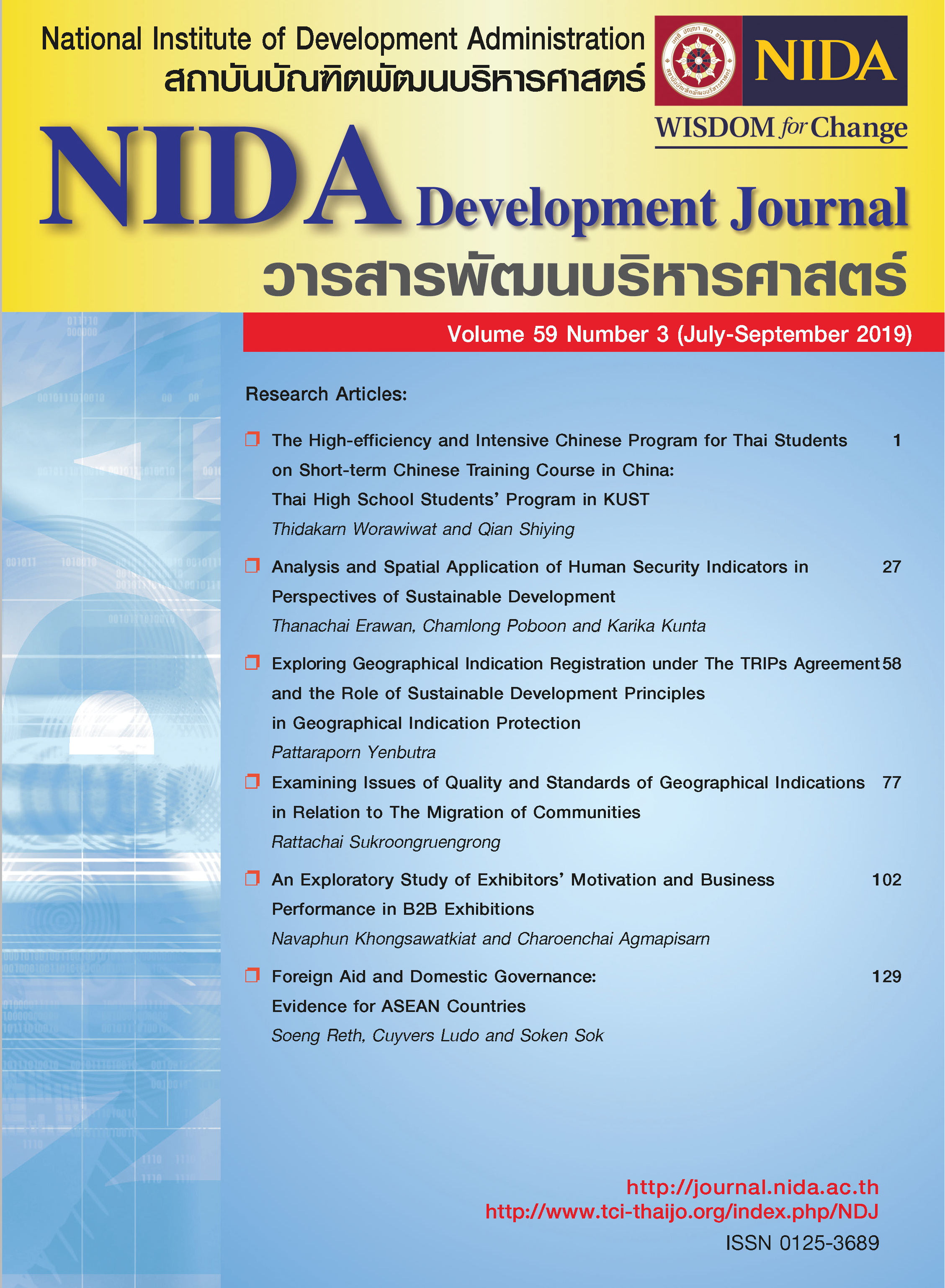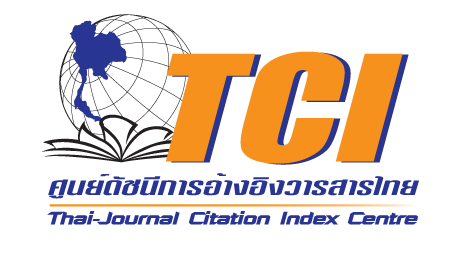Foreign Aid and Domestic Governance: Evidence for ASEAN Countries
Keywords:
Foreign aid, Governance, ASEAN, FDI, Corruption controlAbstract
The impact of official development assistance (ODA) on domestic governance in recipient ASEAN countries is empirically tested on a panel data set over 1996-2015, by using the Hausman-Taylor technique which effectively deals with possible endogeneity issues. The data were from the World Bank’s World Development Indicators and from the Organization of Economic Cooperation and Development (OECD) database. Some important diagnostic tests were carried out. It was found that higher ODA levels are associated with improved corruption control and that a high level of democracy practices promotes the rule of law and better corruption control. Foreign direct investment is crucial in the improvements of governance quality and countries with “British legal origin” maintain higher governance quality. Some implications for the improvements of domestic governance, particularly related to corruption control, for the ASEAN countries and other transitional and developing economies are listed.
References
Al-Marhubi, F. (2004). The determinants of governance: A cross-country analysis. Contemporary Economic Policy, 2(3), 394-406.
Alvi, E., & Senbeta, A. (2012). Does foreign aid reduce poverty?. Journal of International Development, 24(8), 955-976.
Amsden, A. H. (2007). Escape from Empire: The developing world’s journey through heaven and hell. Cambridge, MA: MIT Press.
Arndt, C., Jones, S., & Tarp, F. (2015). What is the aggregate economic rate of return to foreign aid? World Bank Economic Review, 30(3), 446-474.
Askarov, Z., & Doucouliagos, H. (2015). Development aid and growth in transition countries. World Development, 66, 383-399, doi: 10.1016/j.worlddev.2014.08.014
Asongua, S. A., & Nwachukwu, J. C. (2016). Foreign aid and governance in Africa. International Review of Applied Economics, 30(1), 69-88.
Boone, P. (1996). Politics and the effectiveness of foreign aid. European Economic Review, 40(2), 289-329.
Bräutigam, D. A., & Knack, S. (2004). Foreign aid, institutions, and governance in Sub‐Saharan Africa. Economic Development and Cultural Change, 52(2), 255-285.
Brazys, S. (2016). Aid and governance: Negative returns?. European Journal of Development Research, 28(2), 294-313.
Breusch, T. S., & Pagan, A. R. (1980). The Lagrange multiplier test and its applications to model specification in econometrics. Review of Economics Studies, 47(1), 239-253.
Brücker, M. (2013). On the simultaneity problem in the aid and growth debate. Journal of Applied Econometrics, 28(1), 126-150.
Busse, M., & Gröning, S. (2009). Does foreign aid improve governance?. Economics Letters, 104(2), 76-78.
Clemens, M. A., Radelet, S., Bhavnani, B. R., & Bazzi, S. (2012). Counting chickens when they hatch: Timing and the effects of aid on growth. Economic Journal, 122(561), 590-617.
Crivelli, E., & Gupta, S. (2017). Does conditionality mitigate the potential negative effect of aid on revenues?. Journal of Development Studies, 53(7), 1057-1074.
Dadasov, R. (2016). European aid and governance: Does the source matter?. European Journal of Development Research, 29(2), 269-288.
Dalgaard, C-J., & Hansen, H. (2001). On aid, growth and good policies. Journal of Development Studies, 37(6), 17-41.
Degnbol‐Martinussen, J. (2002). Development goals, governance and capacity building: Aid as a catalyst. Development and Change, 33(2), 269-279.
De Jong, E., & Bogmans, C. (2011). Does corruption discourage international trade?. European Journal of Political Economy, 27(2), 385-398.
Dutta, N., Leeson, P. T., Williamson, C. R. (2013). The amplification effect: foreign aid’s impact on political institutions. Kyklos, 66(2), 208-228.
Ear, S. (2007a). Does aid dependence worsen governance?. International Public Management Journal, 10(3), 259-286.
Ear, S. (2007b). The political economy of aid and governance in Cambodia. Asian Journal of Political Science, 15(1), 68-96.
Farazmand, A. (1999). Globalization and public administration. Public Administration Review, 59(6), 509-522.
Farazmand, A. (2001). Globalization, the state and public administration: A theoretical analysis with policy implications for developmental states. Public Organization Review: A Global Journal, 1, 437-463.
Farazmand, A. (2004). Sound governance: policy and administrative innovations. Westport, CT: Praeger/Greenwood Press.
Feeny, S. (2005). The impact of foreign aid on economic growth in Papua New Guinea. Journal of Development Studies, 41(6), 1092-1117.
Finkel, S. E., Pérez-Liñán, A., Seligson, M. A. (2007). The effects of U.S. foreign assistance on democracy building, 1990-2003. World Politics, 59(3), 404-439.
Fukuyama, F. (2013). What is governance?. Governance, 26(3), 347-368.
Gani, A. (2011). Governance and growth in developing countries. Journal of Economic Issues, 45(1), 19-40.
Garcia-Sanchez, I. M., & Cuadrado-Ballesteros, B. (2013). Determinants of government effectiveness. International Journal of Public Administration, 36(3), 567-577.
Goh, S. K., Wong, K. N., & Tham, S. Y. (2013). Trade linkages of inward and outward FDI: Evidence from Malaysia. Economic Modelling, 35, 224-230, doi: 10.1016/j.econmod.2013.06.035
Gradstein, M. (2004). Governance and growth. Journal of Development Economics, 73(2), 505-518.
Greene, W.H. (2012). Econometric analysis. New Jersey: Pearson Education.
Hamilton, E. K. (Ed.). (1989). America’s global interests: A new agenda. New York: W.W. Norton.
Hansen, H., & Tarp, F. (2001). Aid and growth regressions. Journal of Development Economics, 64(2), 547-570.
Hausman, J. A. (1978). Specification tests in econometrics. Econometrica, 46(6), 1251-1271.
Hausman, J. A., & Taylor, W. E. (1981). Panel data and unobservable individual effects. Econometrica, 49(6), 1377-1398.
Hodler, R. (2007). Rent seeking and aid effectiveness. International Tax Public Finance, 14(5), 525-541.
Hsiao, C. (2003). Analysis of panel data. Cambridge: Cambridge University Press (Econometric Society Monograph No. 34).
Hsiao, C. (2005). Why panel data?. Singapore Economic Review, 50(2), 143-154.
Hsiao, C. (2007). Panel data: Advantages and challenges. TEST, 16(1), 1-22.
Jones, S., & Tarp, F. (2016). Does foreign aid harm political institutions?. Journal of Development Economics, 118, 266-281,
https://doi.org/10.1016/j.jdeveco.2015.09.004
Kaufmann, D., Kraay, A., & Mastruzzi, M. (2010). Worldwide governance indicators methodology and analytical issues. Policy Research Working Paper 5430, The World Bank.
Kaya, O., Kaya, I., & Gunter, L. (2013). Foreign aid and the quest for poverty reduction: Is aid to agriculture effective? Journal of Agricultural Economics, 64(3), 583-596.
Keeley, B. (2012). From aid to development: The global fight against poverty. Paris: OECD publishing.
Kersting, E., & Kilby, C. (2014). Aid and democracy redux, European Economic Review, 67, 125-143,
https://doi.org/10.1016/j.euroecorev.2014.01.016
Klerman, D.M., Mahoney, P.G., Spamann, H., & Weinstein, M.I. (2011). Legal origin or colonial history?. Journal of Legal Analysis, 3(2), 379–409,
Knack, S. (2001). Aid dependence and the quality of governance: Cross-country empirical tests. Southern Economic Journal, 68(2), 310-329.
Knack, S. (2004). Does foreign aid promote democracy?. International Studies Quarterly, 48(1), 251-266.
La Porta, R., Lopez-de-Silanes, F., Shleifer, A., & Vishny, R. (1999). The quality of government. Journal of Law, Economics and Organization, 15(1), 222-279.
La Porta, R., Lopez-De-Silanes, F., & Shleifer, A. (2008). The economic consequences of legal origins. Journal of Economic Literature, 46(2), 285–332.
McPherson, M. Q., & Trumbull, W. N. (2008). Rescuing observed fixed effects: Using the Hausman-Taylor method for out-of-sample trade projections. International Trade Journal, 22(3), 315-340.
Minoiu, C., & Reddy, S.G. (2010). Development aid and economic growth: A positive long-run relation. Quarterly Review of Economics and Finance, 50(2), 27-39.
Mohamed, M.R., & Azman-Saini, W.N.W. (2015). Effect of foreign aid on corruption: evidence from Sub-Saharan African countries. International Journal of Social Economics, 42(1), 47-63.
North, D.C. (1990). Institutions, institutional change and economic performance. Cambridge: Cambridge University Press.
Okada, K., & Samreth, S. (2012). The effects of foreign aid on corruption: A quantile regression approach. Economics Letters, 115(2), 240-243.
Plasmans, J. (2006). Modern linear and nonlinear econometrics. New York: Springer Verlag.
Rault, C., Sova, R., & Sova, A. M. (2009). Modelling international trade flows between CEEC and OECD countries. Applied Economics Letters, 16(15), 1547-1554.
Ravallion, M. (2014). On the role of aid in the Great Escape. Review of Income and Wealth, 60(4), 967-984.
Seldadyo, H., Elhorst, J. P., & De Haan, J. (2010). Geography and governance: Does space matter?. Papers in Reginal Science, 89(3), 625-640.
Scott, J. M., Steele, C. A. (2011). Sponsoring democracy: The United States and democracy aid to the developing world, 1988-2001. International Studies Quarterly, 55(1), 47-69.
Svensson, J. (2000). Foreign aid and rent seeking. Journal of International Economics, 51(2), 437-461.
Tavares, J. (2003). Does foreign aid corrupt?. Economics Letters, 79(1), 99-106.
Verbeek, M. (2004). A guide to modern econometrics, 2nd Edition. Chichester: John Wiley & Sons.
Williamson, C. R. (2008). Foreign aid and human development: The impact of foreign aid to the health sector. Southern Economic Journal, 75(1), 188-207.
World Bank (1992). Governance and development. Washington D.C.: The World Bank.
Downloads
Published
How to Cite
Issue
Section
License
Copyright (c) 2020 NIDA Development Journal

This work is licensed under a Creative Commons Attribution-NonCommercial-NoDerivatives 4.0 International License.





